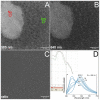A genomic reappraisal of symbiotic function in the aphid/Buchnera symbiosis: reduced transporter sets and variable membrane organisations
- PMID: 22229056
- PMCID: PMC3246468
- DOI: 10.1371/journal.pone.0029096
A genomic reappraisal of symbiotic function in the aphid/Buchnera symbiosis: reduced transporter sets and variable membrane organisations
Abstract
Buchnera aphidicola is an obligate symbiotic bacterium that sustains the physiology of aphids by complementing their exclusive phloem sap diet. In this study, we reappraised the transport function of different Buchnera strains, from the aphids Acyrthosiphon pisum, Schizaphis graminum, Baizongia pistaciae and Cinara cedri, using the re-annotation of their transmembrane proteins coupled with an exploration of their metabolic networks. Although metabolic analyses revealed high interdependencies between the host and the bacteria, we demonstrate here that transport in Buchnera is assured by low transporter diversity, when compared to free-living bacteria, being mostly based on a few general transporters, some of which probably have lost their substrate specificity. Moreover, in the four strains studied, an astonishing lack of inner-membrane importers was observed. In Buchnera, the transport function has been shaped by the distinct selective constraints occurring in the Aphididae lineages. Buchnera from A. pisum and S. graminum have a three-membraned system and similar sets of transporters corresponding to most compound classes. Transmission electronic microscopic observations and confocal microscopic analysis of intracellular pH fields revealed that Buchnera does not show any of the typical structures and properties observed in integrated organelles. Buchnera from B. pistaciae seem to possess a unique double membrane system and has, accordingly, lost all of its outer-membrane integral proteins. Lastly, Buchnera from C. cedri revealed an extremely poor repertoire of transporters, with almost no ATP-driven active transport left, despite the clear persistence of the ancestral three-membraned system.
Conflict of interest statement
Figures





Similar articles
-
New clues about the evolutionary history of metabolic losses in bacterial endosymbionts, provided by the genome of Buchnera aphidicola from the aphid Cinara tujafilina.Appl Environ Microbiol. 2011 Jul;77(13):4446-54. doi: 10.1128/AEM.00141-11. Epub 2011 May 13. Appl Environ Microbiol. 2011. PMID: 21571878 Free PMC article.
-
Systemic analysis of the symbiotic function of Buchnera aphidicola, the primary endosymbiont of the pea aphid Acyrthosiphon pisum.C R Biol. 2009 Nov;332(11):1034-49. doi: 10.1016/j.crvi.2009.09.007. Epub 2009 Oct 14. C R Biol. 2009. PMID: 19909925 Review.
-
Reinventing the Wheel and Making It Round Again: Evolutionary Convergence in Buchnera-Serratia Symbiotic Consortia between the Distantly Related Lachninae Aphids Tuberolachnus salignus and Cinara cedri.Genome Biol Evol. 2016 May 22;8(5):1440-58. doi: 10.1093/gbe/evw085. Genome Biol Evol. 2016. PMID: 27190007 Free PMC article.
-
Serratia symbiotica from the aphid Cinara cedri: a missing link from facultative to obligate insect endosymbiont.PLoS Genet. 2011 Nov;7(11):e1002357. doi: 10.1371/journal.pgen.1002357. Epub 2011 Nov 10. PLoS Genet. 2011. PMID: 22102823 Free PMC article.
-
Genomic revelations of a mutualism: the pea aphid and its obligate bacterial symbiont.Cell Mol Life Sci. 2011 Apr;68(8):1297-309. doi: 10.1007/s00018-011-0645-2. Epub 2011 Mar 10. Cell Mol Life Sci. 2011. PMID: 21390549 Free PMC article. Review.
Cited by
-
Antimicrobial activity and carbohydrate metabolism in the bacterial metagenome of the soil-living invertebrate Folsomia candida.Sci Rep. 2019 May 13;9(1):7308. doi: 10.1038/s41598-019-43828-w. Sci Rep. 2019. PMID: 31086216 Free PMC article.
-
Transcriptome of Dickeya dadantii infecting Acyrthosiphon pisum reveals a strong defense against antimicrobial peptides.PLoS One. 2013;8(1):e54118. doi: 10.1371/journal.pone.0054118. Epub 2013 Jan 14. PLoS One. 2013. PMID: 23342088 Free PMC article.
-
Single-cell genomics unveiled a cryptic cyanobacterial lineage with a worldwide distribution hidden by a dinoflagellate host.Proc Natl Acad Sci U S A. 2019 Aug 6;116(32):15973-15978. doi: 10.1073/pnas.1902538116. Epub 2019 Jun 24. Proc Natl Acad Sci U S A. 2019. PMID: 31235587 Free PMC article.
-
Coordination of host and symbiont gene expression reveals a metabolic tug-of-war between aphids and Buchnera.Proc Natl Acad Sci U S A. 2020 Jan 28;117(4):2113-2121. doi: 10.1073/pnas.1916748117. Epub 2020 Jan 21. Proc Natl Acad Sci U S A. 2020. PMID: 31964845 Free PMC article.
-
Insect-Symbiont Gene Expression in the Midgut Bacteriocytes of a Blood-Sucking Parasite.Genome Biol Evol. 2020 Apr 1;12(4):429-442. doi: 10.1093/gbe/evaa032. Genome Biol Evol. 2020. PMID: 32068830 Free PMC article.
References
-
- Maynard Smith J. Evolution: Generating novelty by symbiosis. Nature. 1989;341:284–285. - PubMed
-
- Bourtzis K, Miller TA. Boca Raton, Florida: CRC Press. 424 p; 2006. Insect Symbiosis, Volume 3; Boutzis K, Miller TA, editors.
-
- O'Neill SL, Hoffmann AA, Werren JH. Oxford: Oxford University Press. 214 p; 1997. Influential passengers : inherited microorganisms and arthropod reproduction; O'Neill SL, Hoffmann AA, Werren JH, editors.
-
- Moya A, Pereto J, Gil R, Latorre A. Learning how to live together: genomic insights into prokaryote-animal symbioses. Nat Rev Genet. 2008;9:218–229. - PubMed
Publication types
MeSH terms
Substances
Grants and funding
LinkOut - more resources
Full Text Sources
Miscellaneous

